Attention Pontonobilia Detectives !
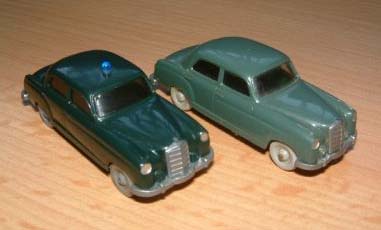
Pon'-ton-o-bil'-ia: n. 1. An object, most often a scaled representation of a Mercedes-Benz Ponton. Also includes any other Ponton minutia suitable for a collection.

Scale models of the Mercedes-Benz Ponton four door sedans are not as common, and certainly more difficult to positively identify than the more abundant roadster, coupé and cabriolet models. Working only from a photograph of limited quality, it can be challenging to identify which Ponton sedan a scale model was actually made to represent. I find it amusing to try and figure it out, without first looking at any annotations on the base plate.
To my eyes, these two Ponton sedans appear to represent the Type 219 sedan. Why? First of all, they appear to have the longer front fenders and hood, which would make them one of the 6 cylinder Ponton sedans, either the Type 219, 220a, 220S or 220SE. The high air intake vents on each side of the radiator shell appear to be absent, so that led to the conclusion that they are indeed one of the 6 cylinder models.
Now, focus on the treatment of the rear door windows to determine whether the model maker intended it to be a Type 219, 220a or 220S / 220SE. On good quality scale models of Ponton sedans, this particular area includes a key design element, which aids in distinguishing between the various 6 cylinder Ponton sedans. If it was meant to be a 219, then there will be no vertical strip indicating the reversed, fixed vent window that is found on the 220a, 220S and 220SE sedans. From this photo, I could not see that detail. However, if the model maker neglected to capture that detail, it becomes much harder to know what was used as a prototype. At that point, flip it over and read the base plate if possible!
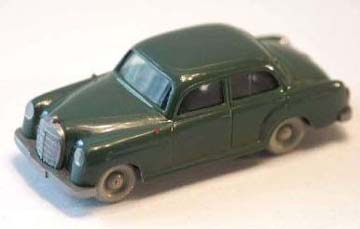
This model looks very similar to the two models above, but this one has the distinctive blinker lights mounted high on the front fenders near the A-pillar. That makes it a 4 cylinder Type 180/190 Ponton sedan. It is made by Wiking (Germany). The scale is 1:87, and it is plastic. Wiking (English pronunciation: "Viking") vehicles are very small, light weight, accurately detailed, and can be found on many H.O. scale model railroads in Germany and around the world. Technically, H.O. is "Half Zero" (H.0.), not "H Oh" as it is commonly known, but that is a discussion better left for another website.
These photos are somewhat difficult to interpret, but I believe that the high air intake vents (at each side of the radiator shell) are present on this scale model. If you are familiar with Wiking toys, you will notice this is an earlier offering based on the wheel color. Early Wiking vehicles had gray wheels. They began using more authentic looking black wheels sometime around the early 1980s.
I have an article on the history of Wiking that I need to un-earth (perhaps in an old "Mercedes-Benz in Aller Welt" magazine) before I can be more specific about the dates. I believe Wiking began making miniature model cars in 1948.

This might be a color variation of the same 1:87 scale Wiking Type 180 Ponton sedan (above). It may also be an example of the Elegant Miniatures series Type 180 sedan by the ELM toy company of China (see below). The air intake vents (at each side of the radiator shell) are a little more obvious in this photo. Also note the side blinker lights.

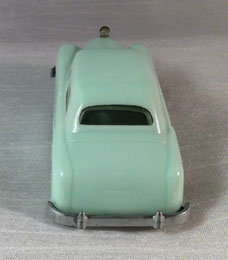
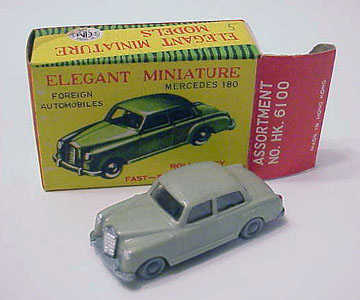
Elegant Miniature series: Plastic Type 180 Ponton sedan (assortment № HK. 6100) made by ELM toys in China
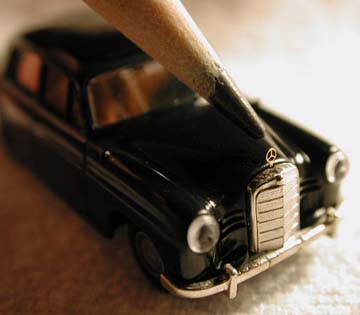
Brekina (Germany) № 2310, 1:87 scale plastic model of the Mercedes-Benz Type 180 Ponton sedan with "photo etched" metal grille star. Note the relative size of the ordinary pencil tip. The detail on these Brekina vehicles is amazing. The tires also include the correct font and lettering, which reads, "Continental." This model was made during the 1990s. Photo courtesy: Jeff Miller / Nikon Coolpix 990.
Siku (Germany) № V52 — Mercedes-Benz Type 180 Ponton police sedan. This is an older Siku model with plastic body, and gray plastic wheels. Most of the trim is intact, including the grille star, rear view mirror, fog lamp, siren, blue beacon on roof, and retractable roof antenna. It is missing an additional auxiliary light on the left front. The bumpers seem to have been painted silver (see brush strokes on the baseplate). Being the first iteration of Siku #V52 (a.k.a. "V52-1"), it dates from about 1956-1959, and includes the special Auer "blaulicht" beacon. The Auer beacon was quite popular in 1950s/1960s Germany. The police badge (star shape) is shown on the doors. This model cost $25 in January 2012, but the Siku "V series" models have become rare in good condition, so prices can go higher. The next Siku model in the V series (V52-2) was another traditional green and white polizei Mercedes-Benz Type W110 190c "Heckflosse" sedan that featured the normal rotating mirror beacon.
Photos courtesy: Jeff Miller / Nikon Coolpix 990 / February 11, 2012
Revell № 08863 1:18 scale Type 180 Ponton Polizei sedan
Shown with its special Auer "blaulicht" beacon. Later models had a normal rotating mirror beacon. The Auer beacon was popular in Germany in the 1950s and 60s. The police badge (star shape) is on the doors.
Brekina (Germany) 1:87 scale plastic Type 180 Ponton sedan with "photo etched" metal grille star. The color appears to be an approximation of the Daimler-Benz color, Moss Green (DB226). Length of this model is approximately 50 mm (2 inches). Photographed at Roskilde, Denmark with the cathedral in the background.
This shot was taken out of a desire to try something new. My own tried-and-true methods (reference the 1:18 scale Revell and Sun Star models on this page) were becoming somewhat routine and standardized. I took a total of 42 experimental images to get this shot of the Brekina Type 180 with the Danish village as a backdrop. I deleted the other shots because there was something distracting about each of them. Not unusual odds in my experience. Whether its full-scale cars or scale models, I typically end up tossing about 35 images for every one kept. Once in a while a shoot goes a little better, but not always. I could have also used Photoshop to merge the scale model with the background, but I believe the lighting looks more natural when the model is part of the surroundings and it makes for a more realistic photo. Photo courtesy: Jeff Miller / Nikon Coolpix 990 / June 19, 2005
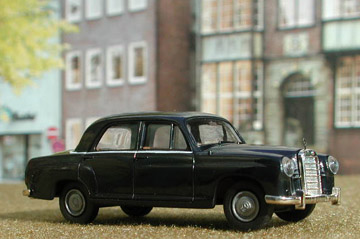
Brekina (Germany) 1:87 scale plastic Type 180/190 sedan with "photo-etched" metal grille star. This example measures 50 mm (2 inches) in length. Note the hubcaps were not painted on this example.
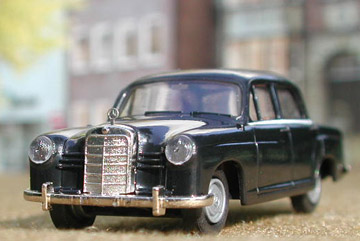
When the camera zooms in on an object of this size, tiny dust particles can appear large and out of scale. They become quite distracting and the subject begins to look much more like a replica and less like the real thing, but the accuracy is still very good on these miniature models, even up close. The background setting is the Town Hall in Jever, administrational seat of the rural district of Friesland, Germany. Photos courtesy: Jeff Miller / Nikon Coolpix 990 / June 20, 2005
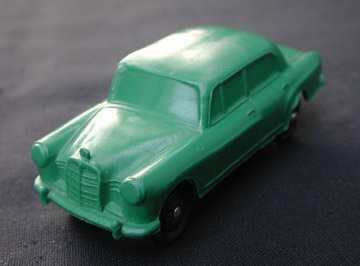
Miniflex (Hong Kong) Type 180 or 190 Mercedes-Benz Ponton sedan
Rubberized, molded plastic material (vinyl), solid windows, black plastic tires on stainless steel axles. Specific manufacturers from the former crown colony of Hong Kong are very hard to identify. Approximately 1:43 scale. Photo courtesy: Jeff Miller / Nikon Coolpix 990 / July 24, 2007
Left: Miniflex (Hong Kong) Type 180 Ponton sedan
Right: Unknown manufacturer (Taiwan) / Baseplate reads, "230SE"
Note the differences in the grill and headlights
These rubberized cars are similar to the type made by Galanite (Sweden) in
the 1960s and 1970s
Photos courtesy: Jeff Miller / Nikon Coolpix 990 / December 26, 2009
Approximately 50 mm long (2 inches), this is the 1:90 scale Schuco (Germany) "Piccolo" series solid die-cast Mercedes-Benz Type 180 Ponton sedan. Black (DB040) variation. Photographed in Germany before a Lower Saxon farm in the "Alten Land" at the lower Elbe. These models can be found (brand new with box) at flea markets and in catalogs for about $10-$15. Photo courtesy: Jeff Miller / Nikon Coolpix 990 / June 19, 2005
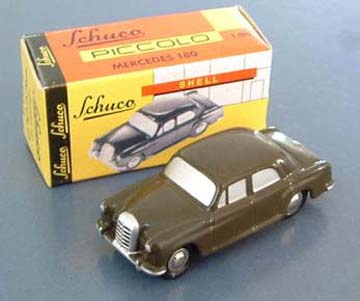
Schuco Piccolo series solid die-cast Mercedes-Benz Type 180 Ponton sedan, 1:90 scale — military green variation

Mercedes-Benz Ponton sedan key chain fob. For the Ponton owner who has almost everything.
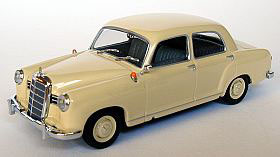
This is the Minichamps 1:43 scale Type 180 Ponton sedan. The side blinkers are not completely accurate. This model shows an amber bulb at the top of the blinker housing. On the prototype, the top of the blinker housing is chrome. Aside from that, the model looks quite good.
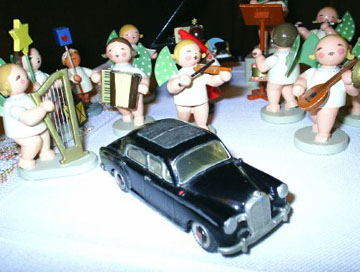
Mercedes-Benz Type 180 sedan (1:43 scale) with Webasto sliding sunroof. Made by Waldorf. From the collection of Steffen Mueller / MuellerLage@aol.com / Berlin, Germany / December 4, 2004
Altaya № AL26 1/43 1960 Mercedes-Benz Type 180Db taxi (Lisbon, Portugal livery)
Altaya's 1:43 scale die-cast metal representation of the 1960 Type 180Db Ponton taxi. This traditional taxi color scheme was used in Portugal through the early 1960s. The chrome trim on this model is plastic.
Altaya № AL26 1/43 1960 Mercedes-Benz Type 180Db taxi (Lisbon, Portugal livery)
In the late 1980s, I had a professor who was originally from Portugal. Before I bought my 1957 Type 190 sedan (June 1989), he was driving a 1980s Mercedes-Benz Type 240D (W123), which he bought new. I was impressed by the appearance of that car in the parking lot. When I bought my black Type 190 sedan, I showed him a photo of it. This prompted him to tell me how his family had owned a taxi business in Portugal, and how they used brand-new Mercedes-Benz Ponton diesels. First, they had to cut holes in the roof for the fitment of the TAXI sign, followed by a paint job in the traditional color scheme (shown here). When the daytime driver finished his shift, he would keep the car running while the night driver took over. The car would run continuously until the each weekend when they would change the oil in the entire fleet.
Altaya № AL26 1/43 1960 Mercedes-Benz Type 180Db taxi (Lisbon, Portugal livery)
Back in the full-scale world, Daimler-Benz offered a radio package for vehicles that were destined to become taxis. Included on the gasoline engine models were noise suppression devices for electric ignition interference. Diesels do not have conventional electric ignition systems but rather, the higher compression ratio of the engine is the catalyst for igniting the diesel fuel. There are no spark plugs, distributor, cap or rotor on diesel engines. On the Ponton era diesels, the fuel enters the cylinders directly by a Bosch mechanical fuel-injection pump. The air is mixed with the fuel at that same moment. Is this too much information for a 1:43 scale model?
Tinplate model of the Type 190Db Ponton sedan
Photos updated June 7, 2017
Tucher, Walther, Nbg. (Germany) Mercedes-Benz 190Db sedan (W121 Ponton) with wind-up motor and steerable front wheels. Note the steering lever protruding from the base of the radiator grille. The rear license plate reads, "TW-W651." Also printed just above rear bumper: "Tucher, Walther, Nbg. made in Germany." Tucher & Walther used old 1950s Blomer u. Schuler tooling and freshened up the lithography for this 205mm (8.5") long red sedan. As of 1998, this reproduction item was available through various specialty collector catalogs. It was also offered in dark blue. Price in 1998 was $83 including shipping.

Tekno (Denmark) № 723. A 1:43 scale die-cast model of the Mercedes-Benz Type 180 Ponton sedan. Sitting on top of the original box.
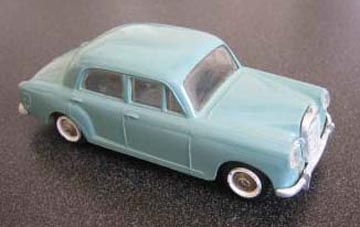
Light Blue color variation of Tekno (Denmark) model number 723. A 1:43 scale die-cast model of the Mercedes-Benz Type 180 Ponton sedan.
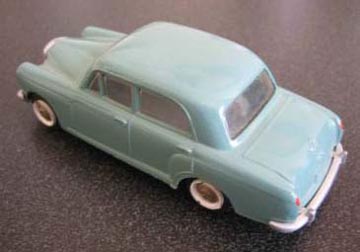

Undercarriage of the Light Blue color variation of Tekno 723
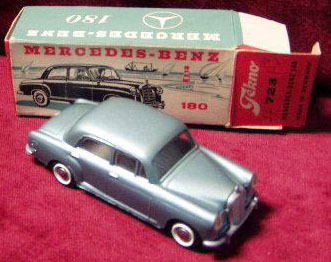
Metallic Blue variation of Tekno 723 - Mercedes-Benz Type 180 Ponton sedan. These can fetch a fair bit when in excellent condition with the original packaging.
| New (replacement) black tires for the Tekno 731 Mercedes-Benz 180 are available! |
| http://www.teknosamleren.dk/produkt/reservedele/daek/tekno/mercedes-benz-180-2 |
|
As of February 2017 – Tires
cost 6.00 DKK
each ($0.85 USD) Four tires (incl. freight to USA) cost 52.64 DKK ($7.74 USD) Peter Frandsen (vendor) / peter4825@hotmail.com / accepts PayPal. |
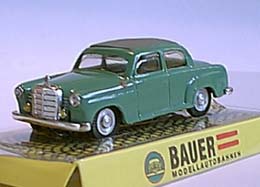
Type 180 Ponton sedan slot-car racer by Bauer. Appears to include a Webasto sliding sunroof and fog lamps. Nice details. Approximate scale: 1:65
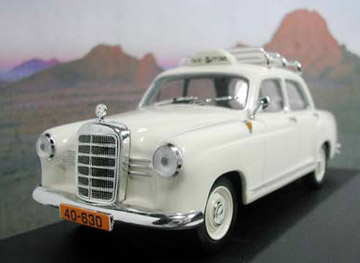
An attractive 1:43 scale die-cast Type 180 Ponton taxi with roof rack. Manufacturer unknown. The grille appears to be modeled after the "early" (pre 1959) style 4 cylinder Pontons, while both bumpers are the later (post 1959) "b" style.
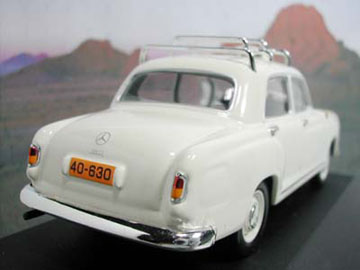
The tail lights should have a white section (for reverse) between the red and amber. The paint looks so thick that it gives the appearance of porcelain instead of die-cast metal. Otherwise, the shape and scale of this model are quite realistic.

Revell № 08973 (black) 1:18 scale die-cast model of the Type W120 180 Ponton sedan. This model was released August 3, 2003. Needless to say, as soon as I saw these, I had to order one to take a closer look. I ordered one from the Netherlands on August 18, 2003 and it arrived in New York on October 2, 2003.
This view shows the original side valve engine (M 136.925) used in the first Type W120 models of 1953
I predicted these would be more popular and available in Europe than in North America.
Photos courtesy: Jeff Miller / Nikon Coolpix 990 / October 4, 2003
Revell № 08974 (light gray) 1:18 scale die-cast model of the Type W120 180 Ponton sedan.
Photos courtesy: Jeff Miller / Nikon Coolpix 990 / May 14, 2004
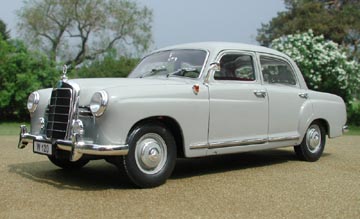
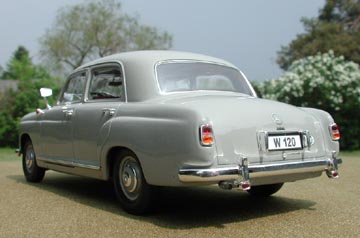
Other than the rear view mirror, which seems to have an overly long stalk, the attention to detail is quite good on these models.
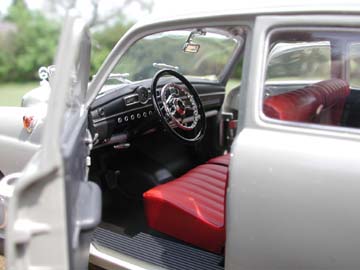
It takes Revell about one year to develop these appealing 1:18 scale models. The development takes place in Hong Kong and in the Chinese province Chen Zhen at the cost of several hundred thousand dollars to the company. The project moves forward only after members of a hundred-strong expert team measure and photograph the actual vehicles, 10,000 kilometers away in Germany.
Revell № 08974 (light gray) 1:18 scale die-cast model of the Type W120 180 Ponton sedan. This particular photo was of Larry Hansen's Revell #08974 model. The enlarged photo includes the reflection of the camera, and Larry Hansen in the bumper. Photo courtesy: Jeff Miller / Nikon Coolpix 990 / July 2, 2005.
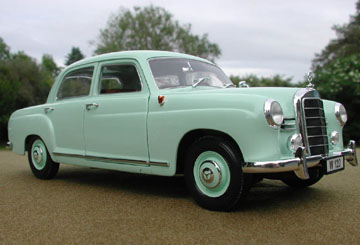
An unusual color for the Revell Type 180 model. This is "Mother of Pearl Green" (DB213). This particular example was ordered through MBUSA where it is referred to it as a Type 180D. To order it (as of June 3, 2005) call 1-800-367-6372 and use MBUSA part number: B6 604 0357. Price was $42 plus freight. Photos courtesy: Jeff Miller / Nikon Coolpix 990 / June 3, 2005
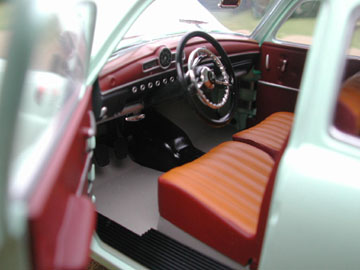
Interior of the 1:18 scale Type W120 180D sedan. The dashboard is accurate down to the heater and ventilation controls. They even included the parking brake handle under the dash. It would have been extra sweet if they also included a miniature owner's manual, a few spare ceramic fuses, a canvas tool roll, and a set of fitted luggage. Revell, "Are you listening?"
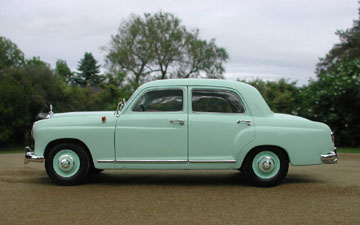
What is there to say about this angle? This is the unmistakable profile of the four-cylinder Mercedes-Benz Ponton sedan. The tall tree in the background became quite familiar to readers of the Pontonobilia page, but it was removed during the summer of 2008, so these photos are now historic.
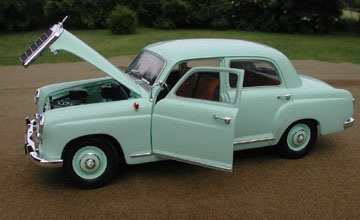
The stalk of the outside rear view mirror is not very accurate. How did they miss that detail? In general, it is hard to find fault with the execution of rest of the model.
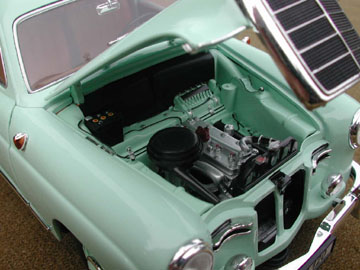
Nice attention to detail. Note the decal at the top of the radiator and the hand painting of the wires, brackets and hose clamps. On the other hand, the heater boxes should be black, not body colored.
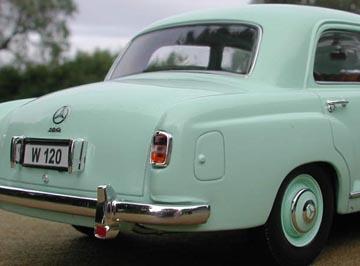
Note the trunk lock is painted, but they must have forgotten about the "fuel" (diesel) door lock. This particular Revell model was a little pricey considering that the Black or Light Gray variations can commonly be found on eBay (in 2008) for about $25. The Mother of Pearl Green was so ugly, I just had to have it! Prior to MBUSA selling the green variation, the only place I saw them was through German eBay vendors. This variation may end up being the most rare and hence the most valuable to future collectors. Who Knows? The Shadow do, but he ain't been talkin' much lately.